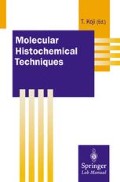Abstract
Fluorescence in situ hybridization (FISH) with chromosomespecific probes is one of the non-isotopic in situ hybridization methods that opens up several new areas of cytogenetic investigation by allowing visual determination of the presence and normality of specific genetic sequences in single metaphase or interphase cells (Pinkel 1986a, 1986b). With this approach, the genetic loci to be analyzed are made microscopically visible in single cells using in situ hybridization with nucleic acid probes specific to these loci. The DNA in target cells is made as a single strand and incubated with single-stranded fluoro chromedirectly- labeled or chemically modified DNA probe under conditions where the probe will anneal only with DNA sequences to which it has high DNA sequence homology. The bound chemically modified probe is made visible by immunofluorescent detection methods. This technique is often called standard FISH.
Access this chapter
Tax calculation will be finalised at checkout
Purchases are for personal use only
Preview
Unable to display preview. Download preview PDF.
References
Du Manoir S, Kallioniemi O.P., Lichter P et al (1995) Hardware and software requirements for quantative analysis of comparative genomic hybridization. Cytometry 19:4–9
Houldsworth J, Chaganti R.S.K. (1994) Comparative genomic hybridization: An overview. Am J Pathol145:1253–1260
Kallioniemi A, Kallioniemi O.P., Sudar D, Rutovits D, Gray J.W., Waldman F.M., Pinkel D (1992) Comparative genomic hybridization for molecular cytogenetic analysis of solid tumors. Science 258:818–821
Kallioniemi O.P., Kallioniemi A, Kurisu W, Thor A, Yu L.C., Smith H.S., Waldman F.M., Pinkel D, Gray J.W. (1992) ERBB2 amplification in breast cancer analyzed by fluorescence in situ hybridization. Proc. Natl. Acad. Sci. USA. 89; 5321–5325
Kallioniemi A, Kallioniemi O-P, Sudar D, Rutovits D, Gray J.W., Waldman F.M., Pinkel D (1993) Comparative genomic hybridization: A rapid new method for detecting and mapping DNA amplification in tumors. Semin Cancer Biol4:41–46
Kallioniemi O.P., Kallioniemi A, Piper J, Isola J, Waldma, F.M., Gray J.W., Pinkel D (1994) Optimizing comparative genomic hybridization for analysis of DNA sequence copy number changes in solid tumors. Gene Chrom Cancer 10: 231–243
Matsuta M, Matsuta M, Hayashi S, Yasumi S, Sasaki K, Kuroda Y, Nishiya I (1996) Reconstructed Three-dimensional Images of Flow-sorted Nuclei Hybridized with Chromosome-specific Probes. J Histochm Cytochem 44: 1337–1343
Matsuta M, Matsuta M, Kon S, Thompson C, LeBoit P.E., Weier H.U., Gray J.W. (1994) Interphase cytogenetics of melanocytic neoplasmic numerical aberrations of chromosomes can be detected in interphase nuclei using antromeric DNA probes. J Cutan Pathol 21:1–6
Persons D.L., Hartmann L.C., Herath J.F., et al. (1993) Interphase molecular cytogenetic analysis of epithelial ovarian carcinomas. Am J Path 142:733–741
Pinkel D, Gray J.W., Trask B, van den Engh G, Fucoe J, van Dekken, H (1986a) Cytogenetic analysis by in situ hybridization with fluorocently labeled nucleic acid probes. Cold Spring Harbor Symp Quant Biol 51: 151–157
Pinkel D, Straume T, Gray J.W. (1986b) Cytogenetic analysis using quantitative, high sensitivity fluorescence in situ hybridization. Proc Natl Acad Sci USA 83: 2934–2938.
Piper J, Rutovits D, Sudar D, et al (1995) Computer image analysis of comparative genomic hybridization. Cytometry 9:10–26
Qian J, Bostwick D.G., Takahashi S, et al.(1995) Chromosomal anomalies in prostatic intraepithelial neoplasia and carcinoma detected by fluorescence in situ hybridization. Cancer Res 55:5408–5414
Schroeck E, Veldman T, Padilla-Nash H et al. (1997) Spectral karyotyping refines cytogenetic diagnostics of constitutional chromosomal abnormalities. Human Genetics 101:255–262
White D.M., Crolla J.A., Ross F.M. (1995) Detection of minimal residual disease in childhood acute lymphoblastic leukemia using fluorescence in situ hybridization. Br J Haematol 91:1019–1024
Author information
Authors and Affiliations
Editor information
Editors and Affiliations
Rights and permissions
Copyright information
© 2000 Springer Japan
About this chapter
Cite this chapter
Matsuta, M., Matsuta, M. (2000). In Situ Hybridization for DNA: Fluorescent Probe. In: Koji, T. (eds) Molecular Histochemical Techniques. Springer Lab Manuals. Springer, Tokyo. https://doi.org/10.1007/978-4-431-67915-8_6
Download citation
DOI: https://doi.org/10.1007/978-4-431-67915-8_6
Publisher Name: Springer, Tokyo
Print ISBN: 978-4-431-68520-3
Online ISBN: 978-4-431-67915-8
eBook Packages: Springer Book Archive

